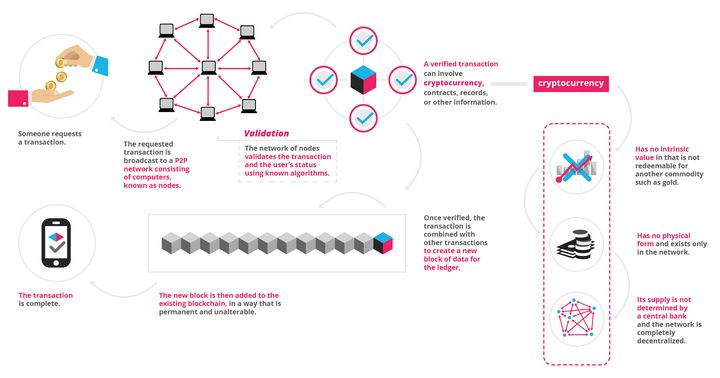
Bitcoin. Ethereum. Cryptocurrency. Tokens. ICOs. If you’re like 99% of Americans, these are freaky sci-fi words that keep popping up in the news. This series will make them feel a little more approachable.
If you made your way here, all these terms probably make you feel something like this:

I get how it can all feel above your...pay grade...and yes, it does take a little mental fortitude, but it’s actually much more straightforward than it initially seems. More importantly, if you don’t start paying attention now, you could be missing out on what is the most important technological revolution this side of XR. It’s about a whole lot more than money—it has massive implications for the fundamental ways we relate to each other.
Blockchain
So, okay. What exactly is blockchain?
“Blockchain is simply an immutable digital distributed ledger that users can store data,” said Lucas Hendren, CTO of SimplyVital Health. “It allows users to trade resources and perform computations securely without a third party involved that is guaranteed to go through.”
Immutable? How’s that work? From Wikipedia:
A blockchain is typically managed by a peer-to-peer network collectively adhering to a protocol for validating new blocks. By design, blockchains are inherently resistant to modification of the data. Once recorded, the data in any given block cannot be altered retroactively without the alteration of all subsequent blocks and the collusion of the network.
Basically, in a typical network (speaking generally here—it depends on how it’s structured), the majority of the nodes (computers operating on the network) have to agree on any change made to the blockchain—which means that prospective hackers would need to gain control of that many nodes to execute any sort of heist. Again, this is a generalization to demonstrate the idea. Ultimately, no system is entirely immune, but compare the handful of instances in this arena to the countless that have occurred in other systems—in cyberspace and IRL.
It’s important to note that blockchain technology is being used for many purposes that extend beyond the financial sector. SimplyVital Health, for instance, is working to revolutionize how hospitals use and exchange medical data using the blockchain—saving everybody involved a whole lot of time and money. (More on them in a later post).
Don and Alex Tapscott put it plainly Blockchain Revolution (emphasis mine):
“The blockchain is an incorruptible digital ledger of economic transactions that can be programmed to record not just financial transactions but virtually everything of value.”
This infographic from Blockgeeks gives a sense of how it works:

Because blockchain is a distributed database, it operates like “a spreadsheet that is duplicated thousands of times across a network of computers,” which the network keeps constant tabs on and updates. This way, there’s no single or centralized source of information the way you have with the Googles and Facebooks of the world; it exists in a public and verifiable forum of millions of computers simultaneously.
People throw around the word “trustless” or “trustless consensus” to describe this system, and that’s because it effectively removes the question of whether or not you need to “trust” other people—it’s all automated on and by the network.
“This excites me because it opens up the world to this entire distributed application network that can allow new kinds of applications and transactions that are potentially more efficient, secure, and cost-effective,” said Hendren. “All without any third parties.”
Looking to the Future
So what does this all mean for us?
- Blockchain systems can be built so that there is no way that they are controlled by a single entity. This question of what data companies can gather—as well as how they can use/sell that data—becomes meaningless.
- No single node can shut down the system. If you’ve traditionally been a proponent of open markets, you’re probably starting to see why blockchain tech is so revolutionary.
You can see why this technology underlies so many cryptocurrencies, but it’s poised to totally change how we interact with each other at the societal level.
Many are claiming blockchain could become a “new Internet”—and whether or not it replaces the existing infrastructure of the web, its impact will be immeasurable. In ten years, the notion of digital reality without blockchain will feel quaint—especially when you start to factor in the unprecedented and unexpected ways it could integrate with AI, XR, and IoT.
In the coming series, we’ll be digging into some of these applications, looking at both the current landscape and what’s on the horizon.
